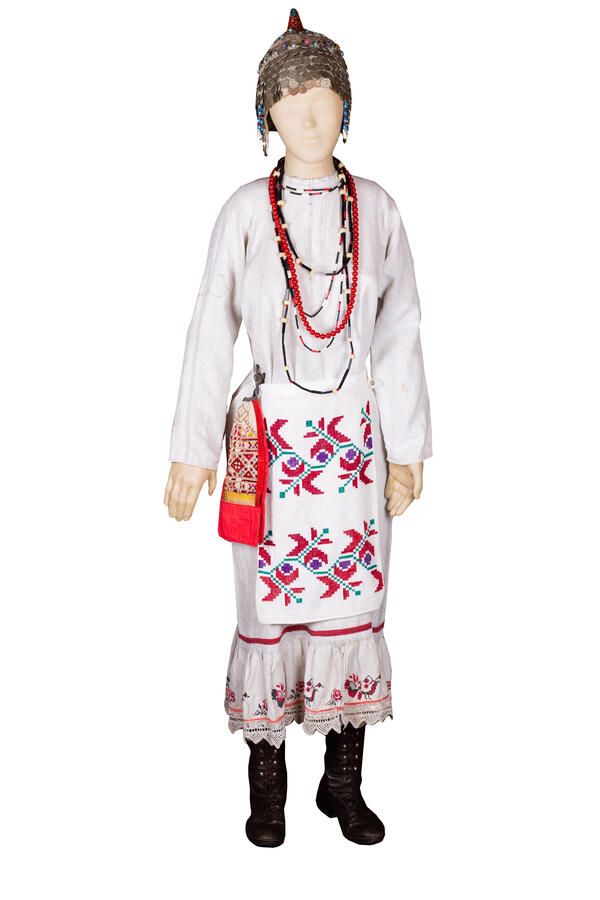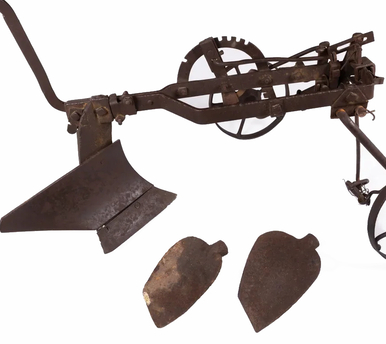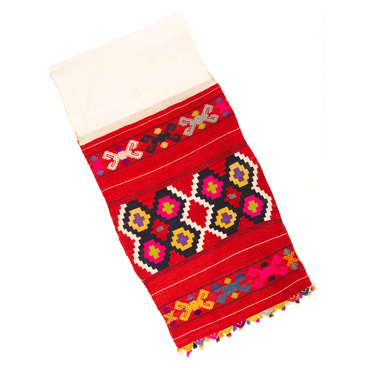Chuvash girls put together multipiece costumes for their weddings. Usually, the bride’s wedding dress consisted of an elegantly embroidered shirt, an apron, a cloth or specially decorated robe (called a shubor), and boots or shoes with stockings. The museum’s exposition showcases a female Chuvash wedding dress made in the 20th century.
At the wedding in her parents' house, the bride first put on girlish jewelry and a helmet-shaped hat with coins (called a tukhya), as well as a wedding veil. According to an ancient custom, first the bride threw off the veil twice, and only the third time did she finally put it on. During the wedding ceremony, there was also a special rite of putting on a head cover (called a surpan) called “surpan syrni”. That took place in the groom’s house: there, the girl was dressed in the costume of a married woman, and more specifically she was wrapped in a surpan and put on a khushpa, which is a hat that has a tail and is decorated with coins.
Generally speaking, any celebratory outfit worn by Chuvash girls and women was rather complex. Usually it consisted of a white canvas shirt (tunic) and a whole system of decorations consisting of stitched and embroidered beads and metal. Headdresses and jewelry made out of beads fashioned from shells, and coins, played a crucial role in rounding out the costume. In the distant past, these definitely played the role of amulets and talismans, and later on they began to be used to tell the owner’s age and social standing. Beads and shells originated as decorations among the ancestors of the Chuvash people in very ancient times. Beads were not only used by the Chuvash for making headdresses, but also for various neck ornaments.
The ornamentation on the female Chuvash costume was secondary to its overall composition. Compared to other parts of the shirt, the hem was embroidered more modestly, and there was a strict cadence in how it was decorated. An important role was played by alternating wide and narrow colored stripes, which included patches and geometric patterns. Chuvash women displayed their refined needlework skills in the decoration of waistcloths. Those were worn both on holidays and regular days. Silk and wool threads were incorporated into the designs. The embroidery was one-sided, and using patches was widespread. A long fringe, usually brown or dark blue, enriched the waistcloth as it moved, playing against the white background of the shirt and enlivening the woman’s entire costume.
At the wedding in her parents' house, the bride first put on girlish jewelry and a helmet-shaped hat with coins (called a tukhya), as well as a wedding veil. According to an ancient custom, first the bride threw off the veil twice, and only the third time did she finally put it on. During the wedding ceremony, there was also a special rite of putting on a head cover (called a surpan) called “surpan syrni”. That took place in the groom’s house: there, the girl was dressed in the costume of a married woman, and more specifically she was wrapped in a surpan and put on a khushpa, which is a hat that has a tail and is decorated with coins.
Generally speaking, any celebratory outfit worn by Chuvash girls and women was rather complex. Usually it consisted of a white canvas shirt (tunic) and a whole system of decorations consisting of stitched and embroidered beads and metal. Headdresses and jewelry made out of beads fashioned from shells, and coins, played a crucial role in rounding out the costume. In the distant past, these definitely played the role of amulets and talismans, and later on they began to be used to tell the owner’s age and social standing. Beads and shells originated as decorations among the ancestors of the Chuvash people in very ancient times. Beads were not only used by the Chuvash for making headdresses, but also for various neck ornaments.
The ornamentation on the female Chuvash costume was secondary to its overall composition. Compared to other parts of the shirt, the hem was embroidered more modestly, and there was a strict cadence in how it was decorated. An important role was played by alternating wide and narrow colored stripes, which included patches and geometric patterns. Chuvash women displayed their refined needlework skills in the decoration of waistcloths. Those were worn both on holidays and regular days. Silk and wool threads were incorporated into the designs. The embroidery was one-sided, and using patches was widespread. A long fringe, usually brown or dark blue, enriched the waistcloth as it moved, playing against the white background of the shirt and enlivening the woman’s entire costume.



